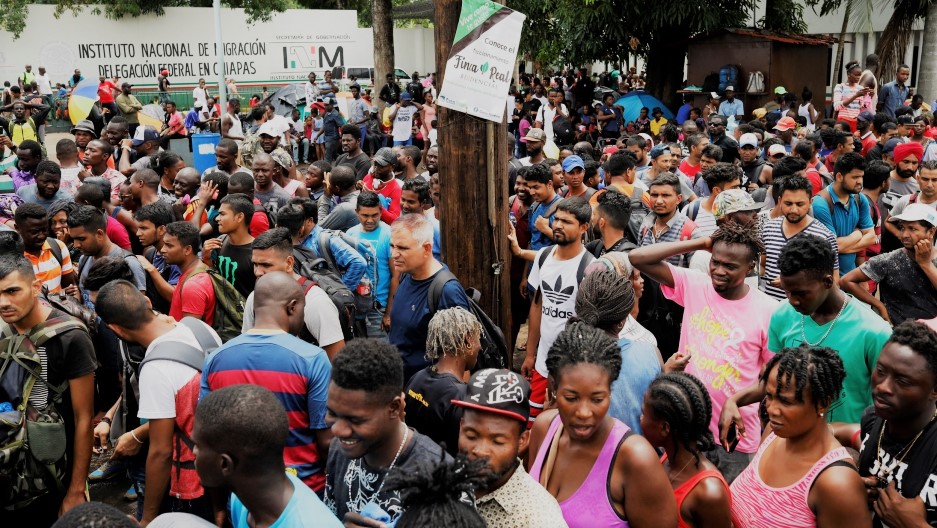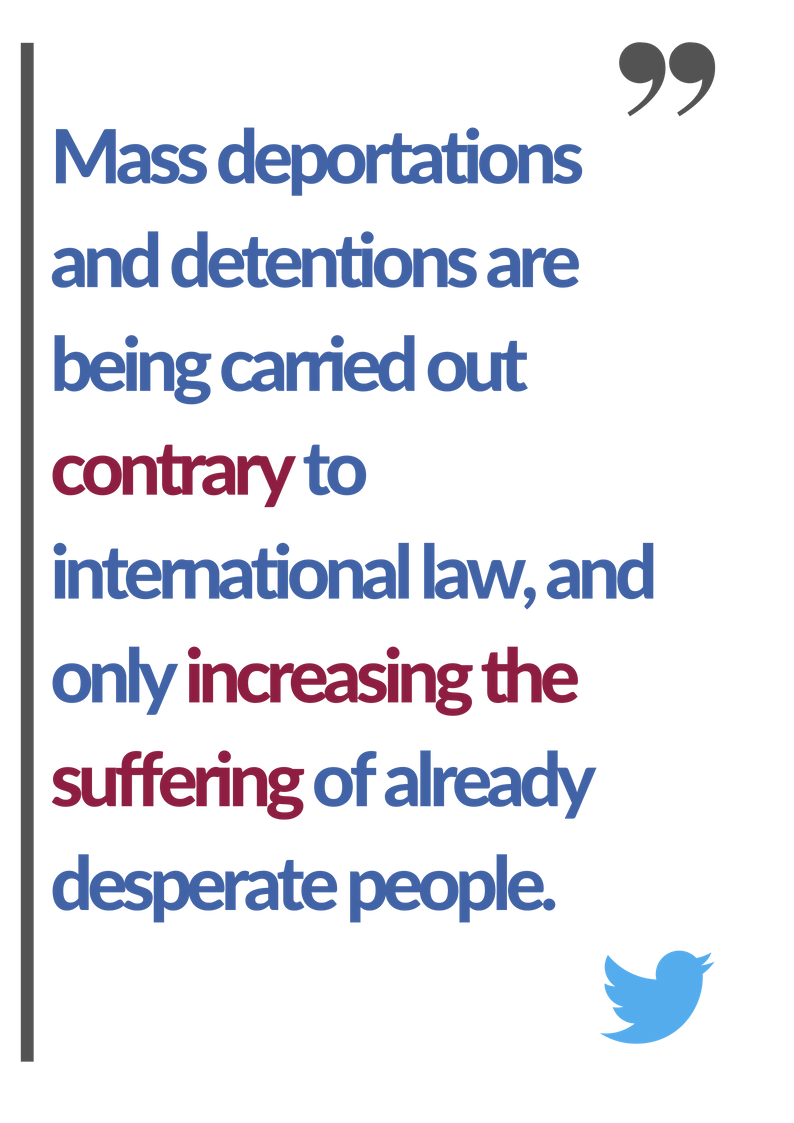
Inside Mexico’s deteriorating migrant facilities: ‘Three days in total darkness’

Migrants waiting to enter an overcrowded Siglo XXI migration facility. (Tapachula, Mexico, May 17, 2019) Photo: Andres Martinez Casares/Reuters
Much has been written – although perhaps not nearly enough – about the cruel, decrepit, and even dangerous conditions inside migrant detention camps along the southern U.S. border.
Now, however, details are emerging about conditions in migrant camps on the other side of the border – conditions exacerbated by the Trump Administration’s immigration policies.
And it is a disturbing picture.
First, some numbers. As of earlier this month, Mexico had detained 99,293 migrants this year and deported 71,110 of them, according to its immigration agency. That’s more than were detained in all of 2017. In June alone, Mexico detained 29,153 migrants, the largest number in any single month in recent Mexican history.
On June 7, President Trump and the Mexican government reached a somewhat vague agreement under which Mexico would slow the flow of migrants through its country toward the U.S. Trump, in turn, would back off his threatened tariffs for 45 days. It is expected that arrests will continue – and observers fear Mexico is woefully unprepared for the additional detainees.
“If more people are detained, there is not the corresponding infrastructure to handle it,” Edgar Corzo of the governmental National Human Rights Commission recently told the Associated Press.
 Indeed, diplomats and human rights officials who have visited detention facilities in Mexico report that conditions have deteriorated dramatically in the almost five weeks since the agreement – some might call it coercion — was reached.
Indeed, diplomats and human rights officials who have visited detention facilities in Mexico report that conditions have deteriorated dramatically in the almost five weeks since the agreement – some might call it coercion — was reached.
“It is an absolute indignity,” said Ranger Morales, Guatemala’s consul in the southern state of Chiapas, the point of entry for almost all of the Central Americans and others entering Mexico. “The citizens of my country are not receiving medical attention. There are sick children. The conditions are the worst I’ve seen.”
For many migrants, hailing not just from the Central American countries of El Salvador, Guatemala, and Honduras, but also from Cuba, Haiti, and countries across the African continent, first stop is Siglo XXI, Spanish for “21st Century.” This is the largest migrant detention facility in Mexico, and is located in the city of Tapachula, near the border with Guatemala.
Reuters recently reported that conditions inside Siglo XXI are “increasingly squalid and overcrowded” as authorities step up the detention of migrants headed for the United States, with inmates languishing for weeks amid medical neglect, a lack of food and water, and people sleeping among roaches, rats and pigeon droppings.
Siglo XXI ’s capacity is said to be 970 people; it frequently has been nearly double that, and once in April, it reportedly housed more than 2,000 people. Other, smaller detention facilities in Mexico have reported populations that are 400 percent to 500 percent over capacity.
Lisdybi Garcia Aguilar, 26, from Cuba, was four months pregnant when migration officials pulled her out of a taxi on April 5 to check her papers, she told Reuters. Garcia was on her way to the immigration office in Tapachula to seek a visa as instructed by migration officials at the border, she said.
Instead, she was taken to Siglo XXI, where her phone and other belongings were taken from her. “They told me it was to ‘regularize’ my status, that all would be well and that this wasn’t a prison, it was a lodging area,” she told Reuters after she was freed. “It was a prison — a prison in every sense of the term.”
U.S. journalists have repeatedly been denied access to Siglo XXI. But the Washington Post, Associated Press, NPR and Reuters each have interviewed people previously detained there. The former detainees paint a grim picture of a prisonlike compound with 16- to 30-foot walls, control towers, security cameras and high-ceiling caged areas where guards patrol above the migrants. There is even a punishment cell called “the well.”
“It’s horrible in there,” Jorge Medina told NPR, referring to Siglo XXI. “They punish people a lot inside, it’s really nasty and dirty where they keep us. And there’s a little solitary confinement room, they kept me there three days in total darkness.”
According to the Washington Post, Mexico’s treatment of migrants is beginning to put strains on the country’s relations with its Central American neighbors. Under international law, when Mexico detains a foreign national in its territory, it is obliged to inform that person’s consulate. But Morales, the Guatemalan consular official in Chiapas, said Mexico recently detained 59 Guatemalans in southern Mexico without informing him or any other Guatemalan officials.
He told the Washington Post that he met them on a routine visit to a detention center in Comitan, where he described the conditions as “miserable,” noting that although the facility was built for a capacity of 90, it was holding 360 migrants.
“They are generating a horrible crisis,” he said. “And what’s worse is that they are not telling us when they detain our citizens.”
 The Trump Administration has strong-armed Mexico into receiving thousands of migrants seeking asylum in the U.S., where they now languish in cities such as Ciudad Juarez and Tijuana, their numbers far outstripping the capacity to absorb them. A new report by Human Rights Watch found that as of June, the number of asylum seekers stuck in Ciudad Juarez outnumbered the spaces available in humanitarian shelters there by 11 to 1. Asylum-seekers are unable to work or pay for food or shelter, and may face violence. If the Trump Administration has its way, the situation will grow far worse, with tens of thousands more sent to these Mexican border cities. The Administration may hope that holding migrants within Mexico will make it harder for us to see their suffering.
The Trump Administration has strong-armed Mexico into receiving thousands of migrants seeking asylum in the U.S., where they now languish in cities such as Ciudad Juarez and Tijuana, their numbers far outstripping the capacity to absorb them. A new report by Human Rights Watch found that as of June, the number of asylum seekers stuck in Ciudad Juarez outnumbered the spaces available in humanitarian shelters there by 11 to 1. Asylum-seekers are unable to work or pay for food or shelter, and may face violence. If the Trump Administration has its way, the situation will grow far worse, with tens of thousands more sent to these Mexican border cities. The Administration may hope that holding migrants within Mexico will make it harder for us to see their suffering.
Mass detentions and deportations in Mexico may be slowing migration into the U.S.; Department of Homeland Security reports that apprehensions at the southern U.S. border declined 28 percent in June, compared with May. But they are being carried out contrary to international law, and only increase the suffering of already desperate people. Desperation will continue to impel thousands to seek refuge from the threats in their home countries.
Exhibit A of why this is was offered by Yanel, a 21-year-old Honduran, who did not give her last name to an Associated Press reporter. Yanel said she was terrified during her two-week stay with her 2-year-old daughter at Siglo XXI. But what she left behind in Honduras was so much worse – a husband belonging to the violent Barrio 18 gang who beat her so badly she nearly miscarried.
Siglo XXI “is worth it,” Yanel said, “if they give you papers.”

